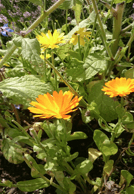Marigold
The summer months bring an abundance of one of my favourite herbs – Marigold. It is a versatile herb with many uses in herbal medicine both traditionally and in modern times. This article will take a look at its attributes. Marigold flowers continuously throughout the summer and is easily grown from seed in most soils. It also self-seeds easily, ensuring a continuing supply each year.
Latin: Calendula officinalis
Other Names: Pot Marigold, Golds, Ruddes, Mary Gowles
Parts Used: Flower petals and flower heads. Traditionally leaves were used more.
Historical Used: The name Calendula in Latin was given by observing the bloom of flowers at the end of the calendar months over summer hence “calends.” It has been used at a nutritious herb for centuries in cooking and medicine. There has been documented use of Marigold as far back as 1655 with a herbalist called Fuller stating “We all know the many and sovereign virtues in your leaves, the herbe Generalle in all Pottage.” He describes using Marigold for headaches, jaundice, red eyes, toothache and ague (an old word for fever). It was associated with the virgin Mary and again with Queen Mary in the 17th century. Culpepper mentions it in his herbal as being hot and dry therefore under the sun. It was used to promote sweating and draw out fever. He also mentions its use in small pox, measles and for easing the jaundice associated with liver disease. It was used during times of plague and pestilence for reducing fevers and for warts and hot swellings. In cheese making, Marigold petals could produce a yellow dye similar to that of Saffron. Externally, it could be used on insect bites and stings as well as on gum disease, nose bleeds and cysts. It was commonly used in broths as a comforter to the heart and spirits, indeed even looking at the plant could supposedly dispel negative thoughts and improve eyesight.
Modern Uses: There are similar uses of Marigold today and with modern scientific investigations we know that the herb contains resins, flavonoids, triterpenes, bitter glycosides, essential oils and mucilage. The resins are antifungal, anti-bacterial and promote wound healing as they as astringent to capillaries. It has shown to be of use in treating bacterial infections caused by staphylococcus and streptococcus. Also similarly, we still use Marigold to stimulate sweating during fevers and it has value in the treatment of liver disease like hepatitis and gall bladder issues.
One of Marigolds key attributes is its anti-inflammatory action, so it is a key herb in treating conditions of the skin. It is useful for healing cuts, old ulcers and slow healing wounds, minor burns, sunburn, rashes, athletes foot, ringworm and thrush. Nursing mothers find it a useful herb to soothe sore nipples and to apply to nappy rash and cradle cap. In conditions like acne where there is often a toxic and internal inflammatory element, Marigold can be used to encourage the elimination of toxins through the lymphatic system and the liver and has shown to enhance the immune system. The wound healing action can be applied internally as well as externally for conditions like gastritis, stomach ulceration and colitis. Another common use today is for thrush and it can be used directly by using a vaginal douche of an infusion of the plant as well as being taken internally as a cleansing antifungal.

